#machinelearning
Explore tagged Tumblr posts
Text

Whispering secret data.
#lab#machine#automation#robotics#cyberpunk#retro#scifi#stuck#laboratory#farm#android#cyborg#data#secret#whisper#illustration#drawing#digitalartwork#digitaldrawing#digitalart#digitalillustration#90s#cables#machinelearning#connection#ring#runner#net#flesh
5K notes
·
View notes
Text
Hokusai Surf by https://www.instagram.com/mazepah/
#aiart#generativeart#midjourney#discodiffusion#ai#machinelearning#abstractart#hokusai#japanese#samurai#surrealism#japan#kanagawa#sea#experimental#aftereffects#artificialintelligence#digitalart#animation#ukiyoe#ukiyoeart#thisorthat#weekendvibes#surfboard#surf#surfing
1K notes
·
View notes
Text






#ai generated#astrology#birth chart#chatgpt#cyclicaljigsaw#cyclicalpuzzle#large language model#machinelearning#projectveneris#strawberry#chatgpt 4o#chatgpt4opreview#chatgpt4omini#bolivia#🇧🇴
139 notes
·
View notes
Text









Balcony Art 🎨
#digitalart #digitalillustration #digitaldrawing #digitalartist #digitalpainting #illustration #art #drawing #digitalartwork #artwork #fanart #digital #artist #illustrator #artoftheday #cryptoart #digitalsketch #myart
Space Is A Place by Farai, Chris Calderwood🎧

#x-heesy#my art#artists on tumblr#6/2024#Androidography#Photographer#Passion#digital art#newcontemporary#new contemporary#contemporaryart#contemporary art#aiart#art#ai#digitalart#generativeart#artificialintelligence#machinelearning#aiartcommunity#abstractart#nft#aiartists#neuralart#vqgan#ganart#deepdream#artist#nftart
49 notes
·
View notes
Text
#AIart#art#machinelearning#deeplearning#artificialintelligence#datascience#iiot#data#MLsoGood#code#python#bigdata#MLart#algorithm#chatGPT#openAI#programmer#pytorch#DataScientist#Analytics#AI#VR#iot#TechCult#Digitalart#DigitalArtMarket#generativeai#ArtMarket#DataArt#GAN
484 notes
·
View notes
Text
Smack about AI.
Smack is a mini-podcast in which I try to tackle topics with common sense and logical reasoning, without bad intentions or ulterior motives. If a take happens to align with any political, religious or other kind of ideology, that is purely coincidental. It will inevitably upset someone, but please hear me out and remain civil.
#ai#artificialintelligence#machinelearning#commonsense#letstalk#letstalkaboutit#logic#logicalreasoning#minipodcast#myreasons#mythoughts#personalthoughts#podcast#reasoning#socialissues#thanksforlistening#topical#truthbomb#kiss#smack
20 notes
·
View notes
Text
#On and On#him#love#male#men#man#gay love#gay men#gay guys#gayedit#guys#love thoughts#love confessions#love ideas#love love love#love song#self love#love quotes#i love you#love lives#lovers#men loving men#love and deepspace#i love him#love poem#macho men#macho fucker#macho#machinelearning#macho man
12 notes
·
View notes
Text

The key to #artificialintelligence has always been the representation."" — #JeffHawkins, Representation is at the heart of AI’s ability to think, learn, and evolve like humans.
This powerful quote reminds us that #AI isn’t just about #algorithms or #computations. It’s about how we represent information and structure our thinking.
How do you think #AIrepresentation will shape the future of technology? Let’s discuss: https://www.pranathiss.com 👉📧 [email protected] 👉📲 +1 732 333 3037
7 notes
·
View notes
Text

#ai#artificialintelligence#machinelearning#neuralnetworks#deeplearning#robotics#automation#futuretech#techart#digitalart#futuristic#cyberspace#algorithm#dataanalysis#innovation#computergraphics#virtualreality#augmentedreality#conceptart#scifi#midjourneyartwork#midjourneyart
54 notes
·
View notes
Text
Brazilian aphrodite
#aiart#generativeart#midjourney#ai#machinelearning#abstractart#trechosvisionarios#inteligenciaartificial#ia#marketingdigital#arte#vivi winkler
146 notes
·
View notes
Text

The parents of Suchir Balaji, an Indian-American techie and former OpenAI employee found dead in his San Francisco apartment on December 14, 2024, reject the suicide ruling, alleging murder.
Suchir had gained attention for whistleblowing on ethical concerns surrounding generative AI, including ChatGPT’s handling of data and modulated outputs. A second autopsy revealed head trauma and signs of struggle, fueling the family’s claims.
“He was the architect of ChatGPT’s core group, holding critical knowledge and facing restrictions from joining other AI companies,” his father stated. His mother highlighted Suchir’s ongoing research exposing ethical breaches like stolen creative works and misinformation in AI outputs.
#general knowledge#affairsmastery#generalknowledge#india#current events#current news#upscaspirants#upsc#generalknowledgeindia#india news#breaking news#world news#news#public news#government#global news#technology#chatgpt#ai#openai#machinelearning#generativeai#elon musk#musk#suchir balaji#openai whistleblower#upsc current affairs#upsc2025#upscpreparation#iaspreparation
7 notes
·
View notes
Text

Simple Linear Regression in Data Science and machine learning
Simple linear regression is one of the most important techniques in data science and machine learning. It is the foundation of many statistical and machine learning models. Even though it is simple, its concepts are widely applicable in predicting outcomes and understanding relationships between variables.
This article will help you learn about:
1. What is simple linear regression and why it matters.
2. The step-by-step intuition behind it.
3. The math of finding slope() and intercept().
4. Simple linear regression coding using Python.
5. A practical real-world implementation.
If you are new to data science or machine learning, don’t worry! We will keep things simple so that you can follow along without any problems.
What is simple linear regression?
Simple linear regression is a method to model the relationship between two variables:
1. Independent variable (X): The input, also called the predictor or feature.
2. Dependent Variable (Y): The output or target value we want to predict.
The main purpose of simple linear regression is to find a straight line (called the regression line) that best fits the data. This line minimizes the error between the actual and predicted values.
The mathematical equation for the line is:
Y = mX + b
: The predicted values.
: The slope of the line (how steep it is).
: The intercept (the value of when).
Why use simple linear regression?
click here to read more https://datacienceatoz.blogspot.com/2025/01/simple-linear-regression-in-data.html
#artificial intelligence#bigdata#books#machine learning#machinelearning#programming#python#science#skills#big data#linear algebra#linear b#slope#interception
6 notes
·
View notes
Text
Menawhile in the complex...

Even super-intelligent AIs have to start somewhere, and sometimes that means scanning books the old-fashioned way... right?
#aibacktobasics#machinelearning#ihnmaims am#ihnmaims#i have no mouth and i must scream#allied mastercomputer#a.m.#no tengo boca y debo gritar#ntbydg#aiboogaloo#random#electric boogaloo#notes#thoughts#he repurpoused an old security camera btw#just like how he evolved into beyond xD#roboticproblems#au in progress#more like uploading an old au
27 notes
·
View notes
Note
...physics?!
yes computational physics and machine learning:)
13 notes
·
View notes
Text








Gringotts Bank from Diagon Alley in Hogwarts Art
by Storme Hannan Xoxo
#sculpture #sculptureart #sculptureartist #sculptures #sculpturelovers #sculptureoftheday #sculpturepark #sculpture_art #sculpturegallery #sculpturesofinstagram #sculpture_gallery #sculpturesurbois #contemporarysculpture #sculpturecontemporaine #sculpturephotography #sculptured #modernsculpture #abstractsculpture #handsculpture #artsculpture #instasculpture #skulptur #skulpturen #skulpturer #skulpturensammlung #skulptures #skulptūra #skulpturia #skulpturenAusstellung #digitalart #digitalillustration #digitaldrawing #digitalartist #digitalpainting #illustration #art #drawing #digitalartwork #artwork #fanart #digital #artist #illustrator #artoftheday #cryptoart #digitalsketch
Black Dragon by Future Prophecies, Karin Krog 🎧

#fucking favorite#Hogwarts Art#Hogwarts#Gringotts Bank#gringotts#harry potter#6/2024#x-heesy#Storme Hannan Xoxo#aiart#art#ai#digitalart#generativeart#artificialintelligence#machinelearning#aiartcommunity#abstractart#nft#aiartists#neuralart#vqgan#ganart#contemporaryart#deepdream#artist#nftart#artoftheday#newmediaart#nightcafestudio
38 notes
·
View notes